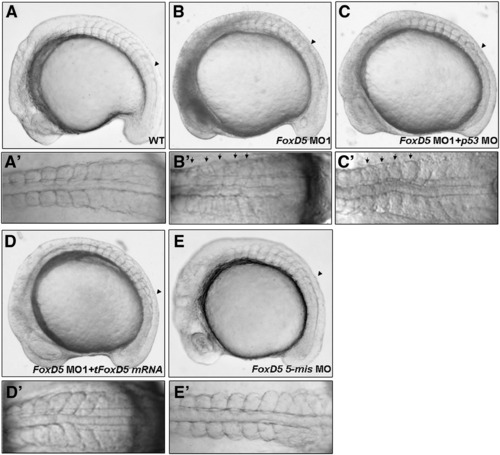Fig. S1
- ID
- ZDB-FIG-091217-99
- Publication
- Lee et al., 2009 - FoxD5 mediates anterior-posterior polarity through upstream modulator Fgf signaling during zebrafish somitogenesis
- Other Figures
- All Figure Page
- Back to All Figure Page
|
Loss of FoxD5 function resulted in the disorganization of somite furrow formation during somitogenesis. (A-E) Lateral views of wild-type embryos (WT) and embryos injected with different materials as indicated at 16 hpf. Compared to WT embryos (A), the arrays of the paired somites became irregular in the FoxD5-MO1-injected embryos (B) and the FoxD5-/p53-double-MO-injected embryos (C). Embryos displayed a normal phenotype when the tFoxD5 mRNA was co-injected with FoxD5-MO1 (D). No phenotype was observed when we injected 4-8 ng of the control MO (FoxD5 5-mis-MO) which contains five mismatched nucleotides of the corresponding FoxD5-MO1. (A′-E′) Dorsal views of trunk somites in WT and embryos injected with different materials as indicated. WT embryos showed column-shaped, maturely formed somites (A′). Ragged shape of the formed mature somites appeared in the embryos injected with either FoxD5-MO1 alone (B′) or FoxD5-MO1 plus p53-MO (C′). However, the morphological structure of somites appeared unaffected, either in the embryos injected with tFoxD5 mRNA plus FoxD5-MO1 (D′) or in the embryos injected with FoxD5 5-mis control MO (E′). |
Reprinted from Developmental Biology, 336(2), Lee, H.C., Tseng, W.A., Lo, F.Y., Liu, T.M., and Tsai, H.J., FoxD5 mediates anterior-posterior polarity through upstream modulator Fgf signaling during zebrafish somitogenesis, 232-245, Copyright (2009) with permission from Elsevier. Full text @ Dev. Biol.

